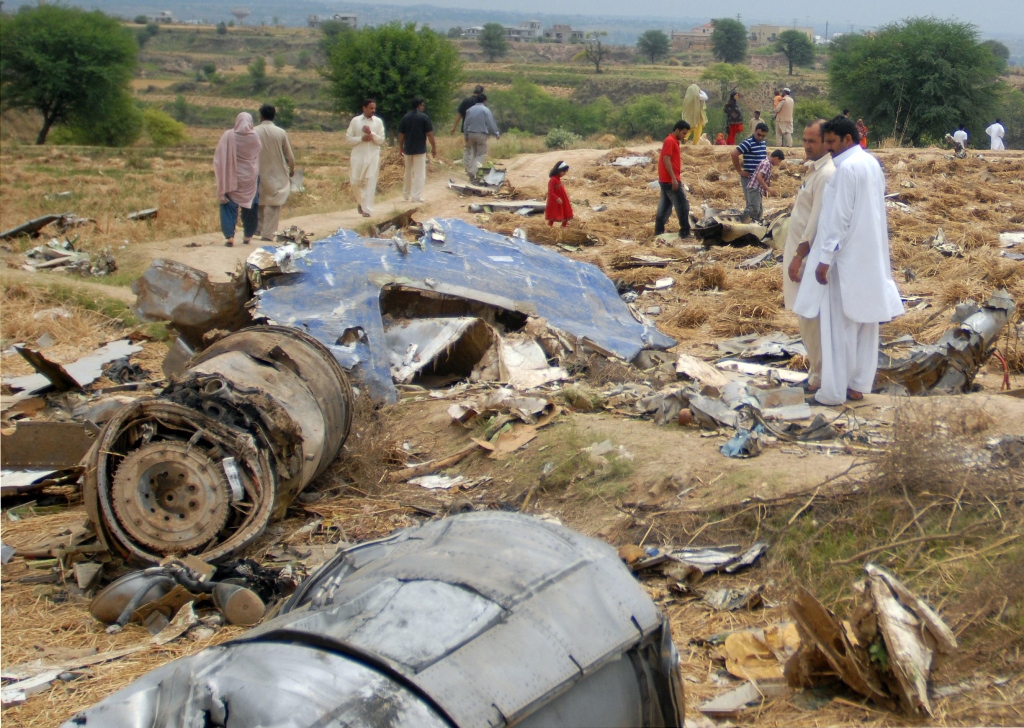
It was the first evening flight in eleven years since Bhoja Airways suspended operations in 1999. The airline resumed service twelve years later and this flight from Karachi to Islamabad was scheduled for Friday, April 20, 2012. A 78-page report released by the CAA includes a blow-by-blow account of BHO 213’s final minutes before it crashed on that Friday, ruling out any technical failure in the aircraft.
There was a thunderstorm warning for Islamabad but the flight’s captain, Noorullah Khan was not perturbed – with more than 10,000 hours of flying experience under his belt, this was just another routine flight for the former air force pilot, aged 58. Flight number BHO 213 departed from Karachi at 5.05pm, with 127 people on board, including six crew members. Khan was assisted by 53-year-old first officer (FO) Javaid Ahmed Malik, also a former PAF pilot. The two pilots had worked together previously and of the 23 flights the captain piloted at Bhoja, Malik had co-piloted 16.

Bhoja Airways, under the leadership of former Managing Director of Shaheen Air International Arshad Jalil, had inducted four Boeing 737s to its fleet. This plane, a 737-236a was manufactured in 1985 and used by British Airways till 1999. The plane served South Africa’s Comair until 2010 when it was grounded. The 737 was purchased by Bhoja in January 2012 and on January 12, Pakistan’s Civil Aviation Authority’s inspectors Shaukat Hameed and Javed Afzal carried out a detailed inspection of the aircraft in Johannesburg. The inspectors noted 28 discrepancies, ranging from peeled-off paint to an engine fan blade’s waviness. All defects were removed in following weeks.
The CAA’s report notes there was no cockpit and crew monitoring system within the airline. The CAA’s Flight Standard Directorate is exempted from any responsibility, as the CAA says it was never told by Bhoja that the pilots would be flying an advanced version of the B-737-200 – the aircraft, possessing an advanced automated flight deck system, requires different treatment when encountering adverse weather conditions. Captain Khan was not trained to handle the situation and his FO had not received simulator training for the aircraft’s automated deck.

At 6.09pm, the report notes, the plane flew above Lahore. At 6:18, the FO asked Khan if he should request a weather forecast for Peshawar – every flight has two alternate cities marked in case of diversion and in this case, it was Lahore and Peshawar. The captain said there was no need. A thunderstorm loomed over Islamabad, with wind speeds at 20 and 34 knots. At 6.24, the captain commented to his FO about the bad weather and at 6:31, the FO asked the captain to take a right to avoid the inclement weather. “No, no we don’t have to go there, we have to land here,” replied Captain Khan, determined to make it to Islamabad.
The flight was cleared for descent at 6.33. Four minutes later, the captain commented on the dark weather but by 6.38, the aircraft prepared to land. Flight BHO-123 then entered the last two minutes of its life. At 6.38, the FO informed the captain that the speed was 220 knots – when at this point, it should not exceed 190 knots. By 6.39, the plane was pushed into a downdraft – a rapid downward push of air. Within four seconds the plane fell from 1900 feet to 900 feet. According to a senior pilot, ‘everything must have been flying inside’ the cabin at this point. By 6.39.28, the captain can be heard shouting, “No, no!”, while the FO says, “Go around, go around.” The Terrain Awareness Warning System sounded an alarm and the FO contacted the control tower. At 6:39:54, the FO shouted, “Stall warning, let’s get out.” Three seconds later, he says his last words, “Go around, go around, sir, go around.” The aircraft crashed 4.5 nautical miles from the Islamabad airport near Hussainabad village. There were no survivors.
Published in The Express Tribune, January 23rd, 2014.
COMMENTS (18)
Comments are moderated and generally will be posted if they are on-topic and not abusive.
For more information, please see our Comments FAQ























Thankyou Mr.imran and fareed for such nice words and prayers......thts the least i can say
@shahid sadiq:
Shahid, my heart goes out to you and i can feel the pain and grief you must have experienced. i was at the graveyard today and stood by the qabars of your son and wife.
as engraved on the tombstone, To Allah We Belong, And To Him We Shall Return
have faith in Allah. May Allah grant your family jannat al firdous. ameen.
Fareed from islamabad
I can't forget all dressed up smiling face of a young professional who lost his life in this tragic accident.
The cause of loss of control of aircraft was 'microburst'. A microburst is a downburst, created by an area of significantly rain-cooled air that, after reaching ground level, spreads out in all directions producing strong winds.
. According to ICAO statistics, 28 aviation accidents, with 700 fatalities were attributed to this phenomenon between 1970 and 1985. Two fatal aircraft accidents in the United States led to extensive study of wind shear. Extensive research was done and a system known as low level wind shear alerting system (LLWAS) was devised. A limitation of such systems is of course that it only detects wind shear at ground level. Hong Kong airport has a sophisticated system for detecting wind shear which combines a network of anemometers with Doppler weather radar and a LIDAR (Light Detection And Ranging) wind shear warning system which can detect the movement of much smaller particles than a conventional weather radar, like dust particles, and therefore can more effectively detect wind shear. At Hong Kong, like Islamabad, wind shear is caused by terrain effects as well as weather.
Unfortunately no such system exists in Pakistan because it is very expensive. We will continue to have such accidents until we can find funds for such a system.
A Down draft can happen unexpectedly to any aircraft at anytime during a thunderstorm. Having said that the pilot should have gone around or diverted to another airport maybe he thought it was a fighter jet and not a commercial jet. Anyway May Their soul rest in peace.
I lost my wife and son in this flight.however in my point of view its very rare that the pilot who is able to see the situation from his eyes would do something deliberately to endanger the lives of the passengers and crew along with himslef.its just that a little lack of decision making creates a situation that gets out of control.i believe that CAA should make a SOP regarding routing islamabad bound aircrafts to an alternate airport in case of a certain decided environamental parameters,so that the pilots role in this sort of decision making is cut entirely.
@m omar- There was another int'l flight which was about to land at that time, but it went to Lahore because of the weather . PIA pilot also at that time diverted one flight to lahore . But local privates one's focus on fuel cost /money and this what happened with clear instruction to land in islamabad as it was probably the 2nd flight of new bhoja. Also why do airlines need to operate grounded aircraft just in this case this Bhoja aircraft was grounded in 2010.
Wasn't the AirBlue incident also attributed to Pilot's "insistence" on not considering FO's opinions?
the airline management put in trained pilots in the cockpit! the owner and management should be tried for murder.
Why does every flight crash in Pakistan happens because of the pilot? and that too who have good experience.Dont the airline owners force the pilots to fly on time etc and not to divert to other aiports to save fuel cost(mentioned in one news article)
Were there any other routine flight landings at Islamabad just minutes before this unfortunate flight? If so then what do people think of those flights? What would we say about other pilots, were they competent or stupid? Answer to the above questions might help to determine the pilot's decision to continue for destination. Given the pilot's extensive experience, if other pilots have discontinued for Islamabad then it is fair to blame this particular pilot. I personally think that this particular flight came under a very rare unpredictable phenomenon, by modern standards, called "microburst". Given the flight vertical distance from land, it wouldn't have escaped from that so easily. Anyhow, pilots should be more careful about weather and criteria for future landings specially with clouds above or near runway needs to be improved.
@A. Khan:
Please check your facts. Police did not let them pay the ransom for their son. You have no shame to make fun of people who were so dishearten by their only son's death that they left this airline, and later this airline was managed by Jalils
@A. Khan: no it's only the name, Bhoja had been taken over by other Investors before Relaunched.
Is this airline owned by the same Bhoja that didn't pay ransom for his kidnapped son, resulting in his death ? If so, how can I expect him to care enough to have properly trained crew and a reliable aircraft to fly me around ? His love of money is greater than his humanity.
If the transcript is a true version of what happened in the final minutes, the captain's ego and hubris got in the way of making a sound decision to divert to another airport or at least do a "go around". This land at any cost approach of Pakistani airlines, ( to save fuel ?), is an extremely dangerous procedure, one that probably doesn't have any precedent around the world.